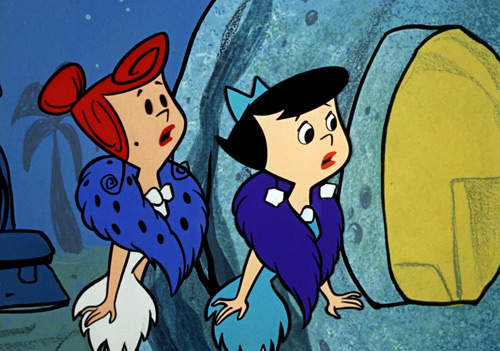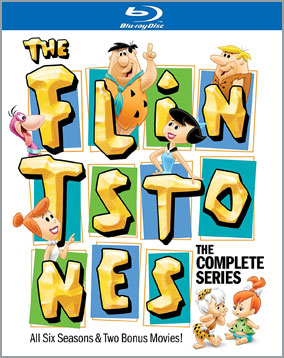
Coate: Which are the series’ standout episodes?
Beck: Real standouts were The Blessed Event (the birth of Pebbles), along with Little Bamm-Bamm… but right alongside those is Ann Margrock Presents.
Cox: I love any of the musical episodes and in my upcoming book on the series Mining Bedrock: The Voices Behind Television’s First Animated Sitcom, The Flintstones, I reveal who actually sang all of those great tunes — from the theme song to little Pebbles and Bamm-Bamm’s surreal performance of Let the Sunshine In.
Pilato: There are so many wonderful episodes… and I remember scenes more than episodes. But I loved the one when Fred became a rock star… or at least thought he was. Or when he was a stunt man for the monster of the tar pit movie that was made in Bedrock. Then there was the episode in which Fred and Barney inadvertently got involved with counterfeit criminals. I also loved the one where Fred dreams that he, Wilma, and the Rubbles visit the future. It had a very cool Twilight Zone aspect to it, and it also reminded me of The Jetsons, which is like The Flintstones in space anyway… future space, that is.
Coate: Which episode is your favorite (if you could name only one)?
Beck: I can’t name only one. The Hot Piano with the unforgettable repetitive “Happy Anniversary” serenade… The Happy Household where Wilma gets a job as the star of The Happy Housewife Show and sings the sponsors song. I guess I might like the ones with special song sequences. The Swedish Visitors with Ole and Sven (and a song, and a Yogi Bear cameo) is up there too. I’m not forgetting the musical episode The Twitch either.
Pilato: Without a doubt, my favorite episode is called Little Bamm-Bamm. Here, Fred and Wilma and Barney and Betty Rubble, discover the truth of what it means to be a parent, as well as a friend. It’s significant not only due to the fact that it introduced the super-powered Bamm-Bamm to the series (thus presenting an additional element of fun-fantasy), but also because of how he is interposed on the show. The action takes place shortly after Wilma gives birth to Pebbles which, in and of itself, is a milestone in the annals of small screen animation. Because of the blessed boulder of an event, Barney and Betty become even more frequent than usual visitors to their neighbors.
Meanwhile, Fred becomes extremely frustrated with the situation. He doesn’t feel he’s spending enough quality time with his new daughter. In a vile moment, he (who more times than not is slightly cranky), is incredibly rude to Betty with a derogatory remark about the Rubbles not having children.
Betty runs away crying. Barney and Wilma are furious. Fred is morose.
In a very poignant and real moment, Betty is next seen, sobbing, in the arms of her husband on a bench in their side-yard. As Barney attempts to console his teary spouse, to near no-avail, the loving couple look skyward and notice a shooting star. A wish is made. The next day, Bamm-Bamm is abandoned at their door, and the Rubbles make every attempt to adopt the infant.
The episode would be significant enough, such that the Rubbles actually adopt Bamm-Bamm, which marks the first time in animated history that cartoon characters gave time to foster children. But it’s this episode’s legitimate moments of emotion recited so believably well by the characters (and their voice-overs) that christens this episode as vintage and definitive.
Like any good series, animated or not, The Flintstones played according to the logic it created. As with the live-action The Honeymooners sitcom that inspired the show, Fred and Wilma’s adventures invite us into its self-contained world, and makes us feel welcome, even though we are the outsiders and, in this case, live-action figures. And The Flintstones’ prehistoric ways remain ageless, mainly because of the intelligent, time-honored episodes like Little Bamm-Bamm.
Coate: If you were to introduce the show to someone, which would be the best gateway episode?
Beck: The first ones — The Flintstone Flyer or The Swimming Pool. That’s the show. Once you “get” the show, then you can move on to Ann Margrock, Perry Stonite and The Gruesomes.
Cox: Any from the second or third season where the characters and animation became locked-in (somewhat).
Pilato: That’s a tough one. But I would say to by-pass the early episodes which are a little awkward, if only because Mel Blanc had yet to find his best “Barney” voice, and the animation was not fully realized yet, in the way both Fred and Barney were drawn. For example, early on, Barney’s eyes are not fully-colored in. Instead, they’re empty circles. And that always bothered me. So, if I were to recommend any episode as the first to watch, I would cut to any segment in the later seasons. All of those worked and looked just fine, on every level.

Coate: Where do you think The Flintstones ranks among the numerous Hanna-Barbera shows?
Beck: Possibly at the top. The show was original, and a product of its time. It’s about the Stone Age — and, like cave paintings, it will live forever.
Cox: The Flintstones will always be the cornerstone of that company. I know it was not their first series, it did not contain their first successful characters, it did not win an Emmy. But the landmark series has never run out of gas. The ’Stones were the building blocks of the company and gave them clout, gave them cash, and provided further opportunities for the studio. Much like another H-B series, Scooby-Doo, it has been a viable franchise in a variety of ways and media.
Pilato: At the top, Number One (with The Jetsons in second place).
Coate: Where do you think the original 1960s The Flintstones ranks among the numerous Flintstones series, spin-offs, movies, etc?
Beck: Well the original series is what all the spin-offs are trying to emulate. The original prime time series is the template. The original series is The Flintstones.
Cox: As the best. The pinnacle.
Pilato: Number One. The sequels were okay, and I enjoyed them. But they were nothing like the original show. And it bothered me that Bamm-Bamm did not retain his super-strength in the Pebbles and Bamm-Bamm Show, which aired on Saturday mornings in the 1970s. That was an inconsistency that messed with the original show’s mythology. And the artwork was a little different, too, in the new shows. Some of the characters, like Wilma, didn’t look right. The sequels, overall, simply didn’t do it for me. And the original show was for all ages, kids, and adults, whereas the sequels, and spin-offs, etc., were specifically-geared just toward kids.
Coate: Do you believe The Flintstones has been adequately represented on home video?
Beck: Yes.
Cox: It will be, finally, when the series is released next month on Blu-ray. [This interview was conducted prior to the release of the new Blu-ray set.] But the cover of the Blu-ray package... oh my god. No comment. I just hope the episode transfers are as beautiful as their Blu-ray release of The Jetsons.
Pilato: I think the show is perfectly represented in that realm.
Coate: What is the legacy of The Flintstones?
Beck: The Simpsons, Family Guy, Bob’s Burgers… Shall I go on?
Coate: Thank you — Jerry, Steve, and Herbie — for sharing your thoughts about The Flintstones on the occasion of its 60th anniversary.
IMAGES
Selected images copyright/courtesy American Broadcasting Corporation, Hanna-Barbera Productions, Screen Gems, Warner Bros. Home Entertainment.
- Michael Coate
Michael Coate can be reached via e-mail through this link. (You can also follow Michael on social media at these links: Twitter and Facebook)





